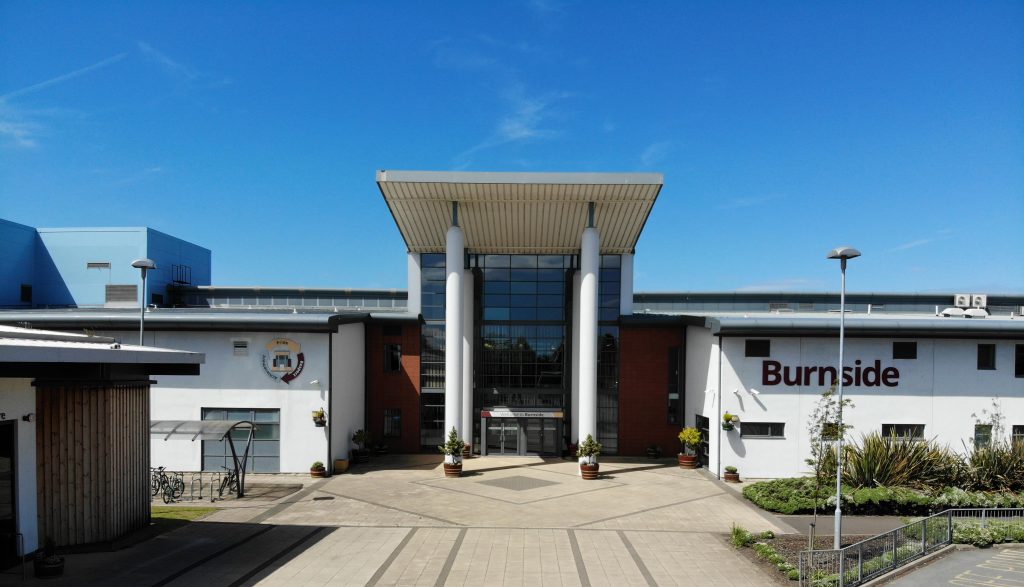Burnside has had several names over the past century. On 15th July 1960 the school was officially opened by the Chairman of Parsons and was known then as Wallsend County Technical School. This new building (shown in the photograph at the bottom left) was added to the same site as the existing Grammar School. Building had commenced on the 8th July 1957 and students were able to use the building from 5th January 1960. The cost for the building work was £252,000, with furniture and equipment costing an additional £27,000.
The school was originally designed for 660 students from the age of eleven and included provision for sixth form courses. The building of the technical college was influenced, as in other areas, by the post-war “Baby-Boom”.
In 1969 on the 3rd September the school was renamed to Burnside High School and encompassed the existing buildings of the former Grammar and Technical schools. A comprehensive high school for students aged 13-18 formed initially from all students at the Technical School, the Central Secondary School, the Western Secondary School. The school opened with a roll of 970 students and 56 members of staff. The first Head Teacher was Mr Austin, with Mr Kirtley as Deputy Head.
The Technical School became known as the Main Building, the Grammar School as the Annex.
In 2002, Burnside expanded to take in students aged 11-18 as years 7 and 8 from Central, Western and High Farm Middle Schools joined. At the same time work began by Kajima (a Japanese Contruction Company) to build a new school on the same site. The school design was to encapsulate modern architecture with Wallsend’s Roman Heritage and as a result the school was designed abstractly on a Roman Mile Castle, which would have been situated every mile on Hadrian’s Wall. The whole project cost around £15m, a big difference from the £280,000 it cost to build the old Technical School in 1960.
In September 2004 Burnside moved into its new building on the site of the Annex and Main Building sites and became known as Burnside College.
Wallsend Partnership of Schools
We are part of the Wallsend Partnership of Schools, a soft federation of all of the schools serving the Wallsend area. The Head teachers of the 15 schools (2 secondary/13 primary/1 special school) meet regularly to discuss common aims. Each school is also represented by a governor on the federation governance group which meets each term.
By pooling financial resources and accessing Extended Services funding the partnership has been able to employ staff to work across the schools.
4 of these staff are part of an ‘Intervention Team‘ of Higher Level Teaching Assistants. They provide intervention support for Maths and English at KS2 and KS3 currently based on termly attainment data provided by each school.
2 of the staff are ‘Transition Learning Mentors‘ supporting the transition of students from KS2 to KS3. In the spring and summer terms they work in the primary schools and in the autumn term follow the Y6 students who they then support to settle into secondary education.
The work of the partnership is coordinated by a management team comprising all of the Headteachers supported by the director of Extended Services for Wallsend.
North Tyneside Learning Trust
We are a Trust school. A Trust School is a local authority maintained school which is supported by a charitable Trust which appoints some of the governors. It remains part of the local authority, family of schools.
It operates within the same frameworks as other maintained schools:
- It teaches the National Curriculum;
- Follows the Schools Admissions Code and;
- Can be inspected by Ofsted.
Teaching staff are employed under the terms of the School Teachers’ Pay and Conditions Document. The local authority funds the school on the same basis as all other local authority schools and retains its intervention powers if there are problems at the school.
Trust schools differ because their charitable Trust (the North Tyneside Learning Trust) establishes a long-term relationship with external partners and involves them in the school’s governance and leadership. The governing body of a Trust School (which retains parents, staff, community and authority governors) remains responsible for all major decisions about the school and its future.
The skills and experience of the Learning Trust appointed governors strengthen the whole governing body and make a contribution to the school’s ethos. The governing body remains responsible for all aspects of the conduct of the school (including the school’s budget and staff), and so responsibilities and accountabilities remain clear.
A Trust School does mean that:
- The school becomes its own admissions authority
- The governing body becomes the employer
- Land, building and assets will be transferred from the local authority (LA), and held by the Trust


